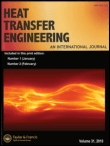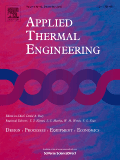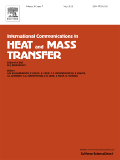
HEAT TRANSFER ENGINEERING
Scope & Guideline
Pioneering research in thermal dynamics and engineering solutions.
Introduction
Aims and Scopes
- Heat Transfer Mechanisms:
Research in this area includes the study of conduction, convection, and radiation heat transfer processes, emphasizing their underlying theories and practical applications. - Heat Exchanger Design and Performance:
This encompasses experimental and numerical investigations aimed at optimizing the design and efficiency of heat exchangers, including innovative configurations and materials. - Thermal Management Systems:
The journal features studies on thermal management in various applications, including electronic cooling, HVAC systems, and renewable energy technologies. - Nanofluids and Advanced Cooling Techniques:
Research focusing on the development and application of nanofluids for enhanced heat transfer performance, including their behavior under various flow and thermal conditions. - Phase Change Materials (PCMs):
The integration of PCMs in thermal energy storage systems to improve energy efficiency and thermal comfort is a significant focus area. - Computational Fluid Dynamics (CFD) Applications:
The use of CFD simulations to model complex heat transfer processes and validate experimental findings is a prominent methodology in submitted studies. - Fouling and Corrosion in Heat Exchangers:
Investigations addressing the challenges of fouling and corrosion in heat exchangers, including mitigation strategies and their impact on thermal performance.
Trending and Emerging
- Sustainable Energy Solutions:
There is a growing emphasis on sustainable energy systems, including the use of supercritical fluids and renewable energy technologies, reflecting global trends towards energy efficiency and environmental responsibility. - Advanced Materials for Heat Transfer:
The exploration of advanced materials, such as nanomaterials and phase change materials, is on the rise, focusing on their applications in enhancing heat transfer performance. - Data-Driven Approaches and Machine Learning:
The application of machine learning and artificial intelligence in predicting heat transfer characteristics and optimizing thermal systems is emerging as a significant trend. - Micro and Nano-Scale Heat Transfer:
Research in micro and nano-scale heat transfer, including studies on microchannels and nanofluids, is gaining traction due to its relevance in electronics cooling and miniaturized systems. - Thermal Energy Storage Systems:
The development of innovative thermal energy storage systems using various technologies, including latent heat storage and thermochemical storage, is increasingly prevalent in the literature.
Declining or Waning
- Traditional Heat Transfer Correlations:
While foundational, many conventional heat transfer correlations are being overshadowed by more advanced computational methods and experimental techniques, leading to a decreased focus on these traditional approaches. - Basic Thermodynamics Applications:
Basic applications of thermodynamics are less frequently addressed as research shifts towards more complex systems and interdisciplinary approaches involving heat transfer. - Conventional Energy Systems:
Research centered on traditional energy systems, such as coal and oil heating processes, is declining as the focus shifts towards renewable energy solutions and sustainable technologies.
Similar Journals

Interfacial Phenomena and Heat Transfer
Pioneering Discoveries in Fluid Flow and Thermal DynamicsInterfacial Phenomena and Heat Transfer is a leading academic journal published by BEGELL HOUSE INC that has rapidly established itself as an essential resource for scholars and industry experts in the fields of engineering, fluid flow, and chemical processes. With an ISSN of 2169-2785 and E-ISSN 2167-857X, this journal focuses on the critical interdisciplinary aspects of heat transfer and interfacial phenomena, offering insights that span across mechanical engineering, chemical engineering, and physical sciences. Despite its relatively recent inception in 2017, it has garnered respectable recognition, with a 2023 Scopus rank placing it in the Q3 category within the disciplines of Engineering (miscellaneous) and Fluid Flow and Transfer Processes, making it a pertinent publication for those interested in cutting-edge research. As researchers and professionals navigate the complexities of interfacial dynamics, Interfacial Phenomena and Heat Transfer serves as a pivotal platform, publishing high-quality, peer-reviewed articles that aim to advance knowledge and stimulate further investigation in this increasingly vital domain.

International Journal of Fluid Mechanics Research
Elevating Scholarly Communication in Mechanical EngineeringThe International Journal of Fluid Mechanics Research, published by BEGELL HOUSE INC, is a pivotal platform for the dissemination of innovative research within the fields of Mechanical Engineering and Physics. With a focus on the intricate dynamics of fluid behavior, this journal has been a cornerstone of scholarly communication since its inception in 1996, continuing to engage a global audience of researchers and professionals through to 2024. With a respectable Impact Factor reflecting its significant contributions to the disciplines—ranking in Q3 for both Mechanical Engineering and Miscellaneous Physics and Astronomy categories—this journal presents a unique opportunity for authors to share their findings in a peer-reviewed environment. Although it does not currently offer Open Access options, all published articles are carefully curated, ensuring high-quality research is accessible to its readership. As the journal navigates the complexities of fluid mechanics, it fosters an interdisciplinary dialogue, bridging theoretical frameworks with practical applications, thereby enhancing understanding and innovation in related fields.

APPLIED THERMAL ENGINEERING
Elevating thermal science through rigorous research and collaboration.Applied Thermal Engineering is a leading international journal dedicated to the field of thermal engineering, published by Pergamon-Elsevier Science Ltd. With an impressive impact factor indicating its significance in the academic community, this journal focuses on innovative research and developments related to energy engineering, fluid flow, and transfer processes, as well as manufacturing and mechanical engineering. Being indexed in top quartiles (Q1) across multiple categories, it ranks exceptionally well on platforms like Scopus, ensuring that contributors reach a wide and relevant audience. The journal supports both open access and subscription options, promoting the dissemination of vital research findings from 1996 to 2024. With its commitment to advancing the discipline and implementing rigorous peer-review processes, Applied Thermal Engineering serves as an essential resource for researchers, industry professionals, and students aiming to stay abreast of the latest advancements and applied methodologies in thermal science.

INTERNATIONAL JOURNAL OF HEAT AND FLUID FLOW
Contributing to Excellence in Mechanical Engineering ResearchFounded in 1979, the INTERNATIONAL JOURNAL OF HEAT AND FLUID FLOW is a premier publication in the fields of mechanical engineering, fluid dynamics, and heat transfer, published by Elsevier Science Inc. With an impressive impact factor and ranking in the Q1 category for Mechanical Engineering and Q2 for Condensed Matter Physics and Fluid Flow and Transfer Processes, this journal is highly regarded for its rigorous peer-reviewed articles that contribute significantly to the advancement of knowledge in these critical areas. Researchers, professionals, and students can access cutting-edge studies that explore the intricacies of thermal and fluid systems, ensuring they stay at the forefront of scientific exploration. The Scopus rankings further affirm its role as a leading source of impactful research, with significant placements in crucial academic categories. Join an active community of scholars committed to innovation and excellence in the exploration of heat and fluid flow phenomena.

Case Studies in Thermal Engineering
Fostering Global Collaboration in Thermal EngineeringCase Studies in Thermal Engineering, published by ELSEVIER, stands as a premier platform for innovative research and analysis in the field of thermal engineering since its inception in 2013. With a robust Open Access model, this journal ensures that groundbreaking findings in fluid flow and transfer processes are readily accessible to a global audience, fostering collaboration and knowledge sharing across disciplines. Situated in the United Kingdom, the journal boasts an impressive impact factor, reflecting its status in the first quartile (Q1) for both engineering (miscellaneous) and fluid flow and transfer processes, as noted in the latest Scopus rankings. Researchers and professionals alike recognize its significance, ranking 9th out of 96 in Chemical Engineering and achieving a notable 91st percentile in its category. By publishing high-quality case studies, the journal aims to advance understanding and applications of thermal engineering principles, making it an essential resource for those looking to stay at the forefront of this dynamic field.

ASME Journal of Heat and Mass Transfer
Exploring the Dynamics of Heat and Mass TransferASME Journal of Heat and Mass Transfer, published by the renowned American Society of Mechanical Engineers (ASME), is a pivotal journal in the fields of mechanical engineering and materials science. With its ISSN 2832-8450 and E-ISSN 2832-8469, this journal aims to disseminate high-quality research focused on the principles and applications of heat transfer and mass transfer phenomena. Despite its recent launch, having converged from 2023 to 2024, it has quickly established a significant presence in the academic community, holding respectable rankings within the Scopus database across various categories—including a 66th percentile rank in Mechanical Engineering. The journal endeavors to foster innovation and collaborative research that advance the frontiers of knowledge in thermal sciences, making it an essential resource for researchers, practitioners, and students keen on exploring the challenges and developments in heat and mass transfer technologies. The journal also embraces an open-access model, ensuring that leading research reaches a broader audience and contributes to global knowledge sharing.

JOURNAL OF POROUS MEDIA
Advancing the Frontiers of Porous Media ResearchJOURNAL OF POROUS MEDIA is a prominent interdisciplinary journal published by Begell House Inc, focusing on the advancement of knowledge related to porous media across various fields, including Biomedical Engineering, Condensed Matter Physics, Materials Science, and Mechanical Engineering. With its ISSN 1091-028X and E-ISSN 1934-0508, this journal serves as a vital platform for researchers and professionals to disseminate groundbreaking findings and foster collaboration within the scientific community. The journal is ranked in the Q2 and Q3 quartiles in multiple categories as of 2023, demonstrating a notable standing in Scopus rankings across several engineering and physics disciplines. Though not an open-access journal, it provides essential insights and advancements within the field of porous media research, encouraging innovative exploration and practical applications in real-world scenarios. Published from 1998 through 2024, JOURNAL OF POROUS MEDIA is an invaluable resource for students, researchers, and industry experts seeking to deepen their understanding of complex porous systems.

Journal of Engineering Thermophysics
Exploring the synergy of heat and engineering excellence.Journal of Engineering Thermophysics, published by PLEIADES PUBLISHING INC, is a premier academic journal dedicated to advancing the field of thermophysics and its applications across a variety of engineering disciplines. With an ISSN of 1810-2328 and an E-ISSN of 1990-5432, this journal offers an essential platform for researchers and professionals to disseminate cutting-edge findings on the interplay between thermal processes and engineering systems. As of 2023, it is recognized within the Q3 category in key fields such as Condensed Matter Physics, Energy Engineering and Power Technology, Environmental Engineering, and Modeling and Simulation. Moreover, the journal contributes to an important dialogue in the environmental sciences, ranking 111 out of 197 in Environmental Engineering, and positions itself prominently within the academic landscape from its establishment in 2007. Although currently not an open-access journal, it facilitates a selective yet impactful communication of research that drives innovation and knowledge in the thermal sciences. For those engaged in understanding the thermal dynamics essential for sustainable engineering solutions, the Journal of Engineering Thermophysics is the go-to resource for published research, reviews, and advancements in the field.

Journal of Thermal Science
Elevating research standards in thermal science since 1992.Journal of Thermal Science is a prestigious academic publication dedicated to the field of thermal science and its applications. Published by SPRINGER, this journal has been at the forefront of knowledge dissemination since its inception in 1992 and continues to provide a platform for researchers and professionals to share their innovative findings through high-quality peer-reviewed articles. With its ISSN 1003-2169 and E-ISSN 1993-033X, the journal covers a diverse array of topics related to thermal processes, materials, and engineering, significantly contributing to advancements in Condensed Matter Physics. In the latest rankings, it holds a commendable Q2 category in the 2023 quartiles, further highlighting its relevance with a Scopus ranking of #183/434 in its field, placing it in the top 57th percentile. While currently not offering open access, the journal strives to bridge the gap between theory and practice, making substantial impacts on both academia and industry. Its continued exploration of cutting-edge research ensures that it remains a key resource for students and professionals looking to expand their knowledge and foster innovation in thermal sciences.

INTERNATIONAL COMMUNICATIONS IN HEAT AND MASS TRANSFER
Driving discoveries in critical engineering disciplines.INTERNATIONAL COMMUNICATIONS IN HEAT AND MASS TRANSFER, published by Pergamon-Elsevier Science Ltd, stands at the forefront of research in the fields of heat and mass transfer, making significant contributions to the knowledge base since its inception in 1983. With an impressive reputation reflected in its 2023 Q1 rankings in Atomic and Molecular Physics, Chemical Engineering, and Condensed Matter Physics, this journal appeals to a wide spectrum of scholars, professionals, and advanced students engaged in these critical disciplines. The journal is indexed under ISSN 0735-1933 and E-ISSN 1879-0178, and it maintains a rigorous peer-review process to ensure the high quality of published papers. Although not an Open Access journal, its strategic importance is underscored by its ranking in Scopus with notable positions in various sub-disciplines, securing its place in the elite 89th to 93rd percentiles. For those looking to deepen their understanding and contribute to advancements in thermal and mass transfer phenomena, INTERNATIONAL COMMUNICATIONS IN HEAT AND MASS TRANSFER serves as an essential resource for cutting-edge research and innovative applications.